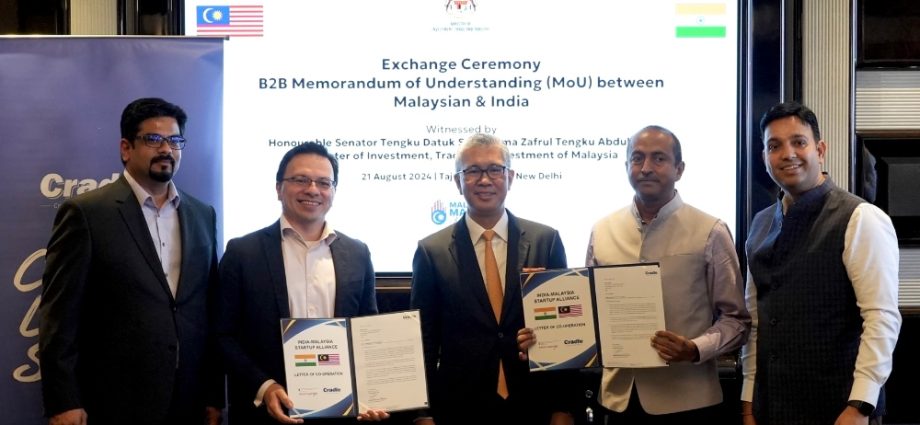Cradle, Invest India form alliance to strengthen startup ecosystems in both nations
- Partnership aims to boost tech startup collaboration in both nations
- Matchmaking programmes aim to generate US$23 mill in investments, contracts

Cradle Fund Sdn. Bhd. (Cradle), the focal point agency for Malaysia’s startup ecosystem, and Invest India, an investment promotion and facilitation agency under the Government of India, have exchanged a Letter of Cooperation (LOC) to establish the India-Malaysia Startup Alliance (IMSA) through Startup India. This strategic partnership aims to foster greater engagement and collaboration among technology-based startups in both nations.
Startup India, a flagship initiative of Invest India, intends to catalyse startup culture and build a strong and inclusive ecosystem for innovation and entrepreneurship in India. The initiative, established under the Department for Promotion of Industry and Internal Trade, Ministry of Commerce and Industry, Government of India, plays a crucial role in facilitating foreign investment into its country and promoting its economic growth.
Commenting on the LOC between the two agencies, Chang Lih Kang, minister of Science, Technology, and Innovation (MOSTI), said, “India and Malaysia have benefitted from the long-standing relationship built on mutual respect and shared prosperity. This alliance between Cradle and Invest India is a natural extension of our strong economic and commercial ties.
“As Malaysia ranks among India’s top trading partners, this partnership will encourage local startups to venture into India’s 1.4 billion-strong market and will also provide pathways for quality Indian startups to penetrate the ASEAN market through Malaysia. This is aligned with the Malaysia Startup Ecosystem Roadmap (SUPER) 2021-2030, and its aspiration to place Malaysia among the top 20 global startup ecosystems by 2030,” he added.
Norman Matthieu Vanhaecke, Group CEO of Cradle, emphasised that, “This alliance between Cradle and Invest India, a first for both countries, not only strengthens our mutual commitment but also fosters a closer, more impactful, and sustainable cross-border tech entrepreneurial synergy, driving transformative growth in India and Malaysia’s startup ecosystem,” he said.
The LOC exchange ceremony was held in New Delhi on 21 August 2024, in conjunction with Malaysia’s official visit to India, led by Prime Minister Anwar Ibrahim. This alliance is envisioned as the primary bilateral framework for startup and innovation engagement between the two countries.
The exchange ceremony was represented by Norman of Cradle and Shri Sanjiv, joint secretary, Department for Promotion of Industry and Internal Trade, Ministry of Commerce and Industry, Government of India, witnessed by Tengku Zafrul Tengku Abdul Aziz, Malaysia’s minister of Investment, Trade, and Industry (MITI).
Over the next year, IMSA will focus on enhancing mutual awareness of the development of startup ecosystems in Malaysia and India, emphasising government interventions, industry collaboration, and university engagement.
Key initiatives under IMSA will include virtual capacity-building sessions, knowledge-sharing events, and the facilitation of startup matchmaking programmes. These efforts will culminate in the participation of Malaysian and Indian delegations, as well as other startup ecosystem players, at major events such as the Startup Mahakumbh 2025 and the ASEAN-India Startup Festival 2025, to be held in Kuala Lumpur as part of the country’s ASEAN Chairmanship.
The matchmaking programmes are targeted to catalyse investment and commercial contract value close to US$23 million (RM100 million) from potential venture capitalists and corporates between ASEAN and India. Additionally, these programmes will connect startups with relevant stakeholders to explore opportunities for market expansion, research and development, and deeper industry collaboration.




 Jacqueline Poh ( pic ), managing director of EDB, said:” The CVL programme has been a catalyst for companies to innovate for growth by leveraging Singapore’s world-class business ecosystem. The program confirms EDB’s dedication to working with businesses to create new ventures and foster mutually beneficial partnerships between corporations and companies.
Jacqueline Poh ( pic ), managing director of EDB, said:” The CVL programme has been a catalyst for companies to innovate for growth by leveraging Singapore’s world-class business ecosystem. The program confirms EDB’s dedication to working with businesses to create new ventures and foster mutually beneficial partnerships between corporations and companies.
.jpg)
.jpg) His back was against the wall by that point, so the timing could n’t have been better. It was not an easy time, he admits. There was little to no money being made, and the statement” We were running out of money then” was true.
His back was against the wall by that point, so the timing could n’t have been better. It was not an easy time, he admits. There was little to no money being made, and the statement” We were running out of money then” was true.


 The new AWS Region in Malaysia, led by Prasad Kalyanaraman ( pic ), vice president of infrastructure services at AWS, enables organizations across Asia Pacific to fully exploit the potential of the world’s most extensive and reliable cloud, assisting customers in deploying advanced applications with a wide set of AWS technologies like AI and ML. With today’s release, AWS is happy to support Malaysia’s modern transformation and help promote its function as a local hub for AI”.
The new AWS Region in Malaysia, led by Prasad Kalyanaraman ( pic ), vice president of infrastructure services at AWS, enables organizations across Asia Pacific to fully exploit the potential of the world’s most extensive and reliable cloud, assisting customers in deploying advanced applications with a wide set of AWS technologies like AI and ML. With today’s release, AWS is happy to support Malaysia’s modern transformation and help promote its function as a local hub for AI”.

 sation for Sustainable Development Goal 11 and the United Nations ‘ Centre of Excellence for United for Smart Sustainable Cities program. Through its 3D visualisation platform, Graffiquo’s global commitment to smart and sustainable urban development is highlighted in this partnership.
sation for Sustainable Development Goal 11 and the United Nations ‘ Centre of Excellence for United for Smart Sustainable Cities program. Through its 3D visualisation platform, Graffiquo’s global commitment to smart and sustainable urban development is highlighted in this partnership.






